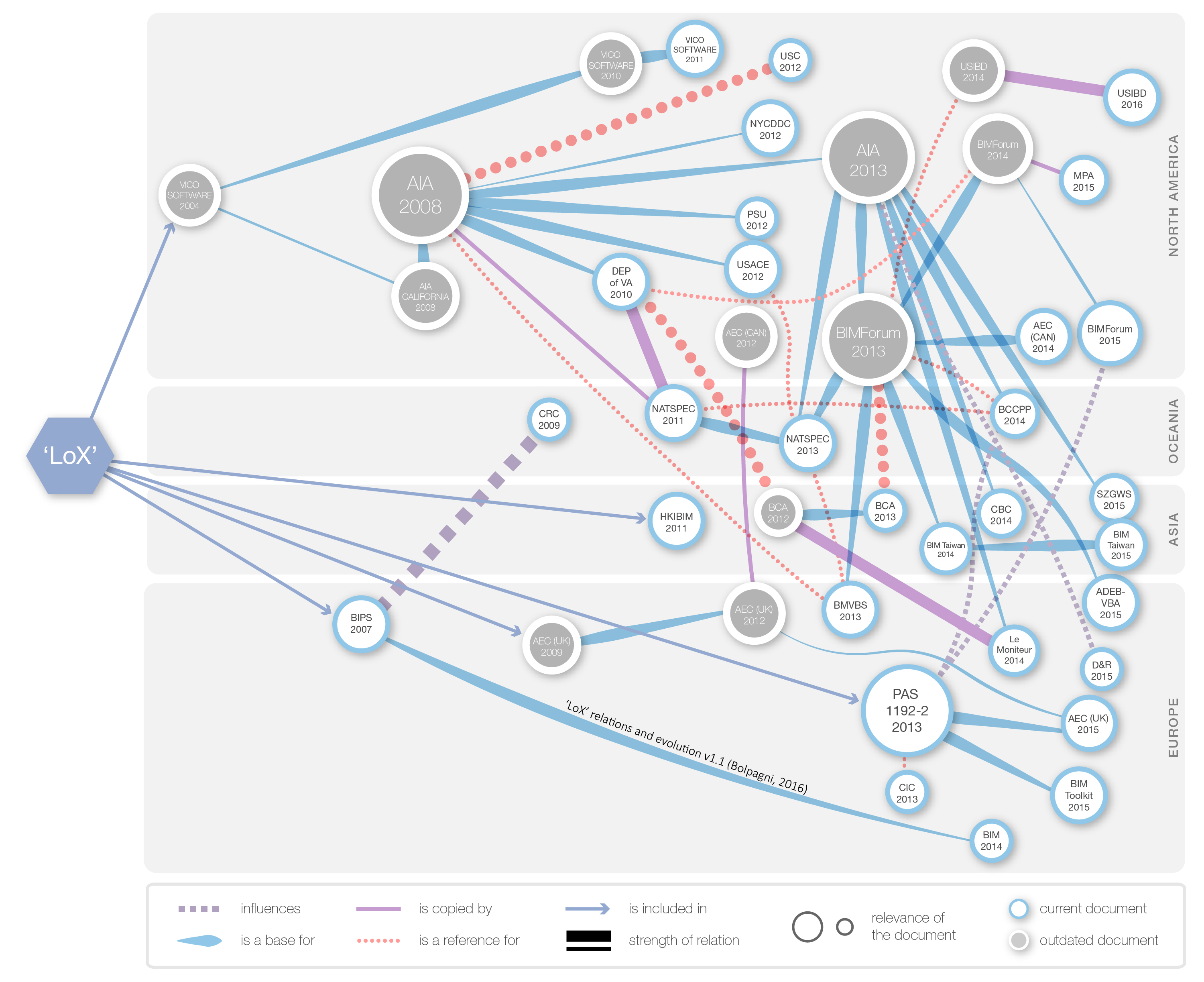The New Lexicon of UK BIM
Search any BIM forum, and you’ll find the same queries:
- “What’s LOD 350 mean in the UK?”
- “Scan-to-BIM for asset owners – what level of detail is needed?”
- “How do we align with ISO 19650 and still meet the BEP?”
Welcome to the world of BIM alphabet soup — LOD, LOI, LOIN — and the standards behind them: PAS 1192, ISO 19650, BS EN 17412, and now BS EN ISO 7817.
At Parametrix, we navigate this complexity every day in our Scan-to-BIM and digital delivery projects. Whether we’re creating a condition survey model of a historic hospital, or structuring digital twins to support FM operations, the key is always the same:
Get the right data, in the right format, at the right time — no more, no less.
In this guide, we break down the history and evolution of these terms, explain the current UK BIM framework approach, and offer actionable advice to design teams, asset owners, and Scan-to-BIM specialists.

Source: https://www.bimthinkspace.com/2016/07/the-many-faces-of-lod.html
How LOD Became BIM’s Backbone
The concept of Level of Detail (or Development) began as a way to standardise expectations in BIM deliverables. But as countries and standards bodies adapted the idea to local needs, it evolved into a complex ecosystem of competing definitions. Here’s a chronological breakdown of how LOD emerged, spread, and fractured, and how it’s converging again under ISO guidance.
| Year | Organisation / Standard | Country / Region | Key Contribution | Notes |
|---|
| 2004 | Vico Software (Model Progression Specification - MPS) | USA | First formal concept of LOD progression | Defined model content by project stage; introduced the term "Level of Detail" as a maturity model. |
| 2008 | AIA E202 BIM Protocol | USA | Official LOD 100–500 framework | AIA introduced 5-tier LOD system; widely adopted globally. Defined levels from conceptual (LOD 100) to as-built (LOD 500). |
| 2013 | BIMForum LOD Specification | USA | System-level clarity and examples | Expanded AIA’s E202 with object-specific definitions (e.g. doors, beams). Warned against the term “LOD 300 model.” |
| 2009–2014 | Various national BIM guidelines (e.g. Australia, NZ, Denmark, France) | Global | Local adaptations and variations | New Zealand introduced LoD, LoA, LoI, LoC separation. Denmark adopted 7-level “Information Levels.” France and Germany built hybrid systems. |
| 2013 | PAS 1192-2 (BSI) | UK | Introduced “Level of Definition” = LOD + LOI | UK split graphical and non-graphical maturity into two scales: Level of Detail and Level of Information. Mapped loosely to RIBA stages. |
| 2015 | NBS BIM Toolkit | UK | Digital Plan of Work, with LOD/LOI examples | 400+ object definitions by project stage. First publicly accessible UK resource to standardise BIM object expectations. |
| 2016 | USIBD Level of Accuracy (LoA) Specification | USA | Added geometry tolerance to as-built modelling | Key for Scan-to-BIM; defines LoA20 (±5 mm) through LoA60 (±50 mm). Focused on measured/modelled accuracy, not detail. |
| 2018 | ISO 19650-1 & -2 | International | Global standard for information management | Did not use LOD explicitly; introduced need for purpose-led information definition. |
| 2020 | BS EN 17412-1 | EU/UK | Introduced “Level of Information Need (LOIN)” | Formalised LOIN as a three-part concept: Geometry + Alphanumeric Data + Documentation, based on use case. |
| 2024 | BS EN ISO 7817-1 (supersedes BS EN 17412) | International | Current ISO standard for defining LOIN | Replaces fragmented LOD/LOI frameworks with flexible, purpose-led structure. Aligns global practice and supports ISO 19650. |
Understanding the LOD timeline isn’t academic, it’s practical project risk management. At Parametrix, we’ve seen too many projects misfire due to:
- Vague “LOD 500” contract clauses
- Over-modelled components in early stages
- Confusion between U.S. and UK interpretations
By situating your information requirements in this historical context and anchoring them to the latest ISO standards, you create clarity, consistency, and confidence across your project team.
UK Divergence – The Rise of LOD + LOI
Unlike the U.S., the UK introduced a split definition:
- LOD (Level of Detail): geometry only
- LOI (Level of Information): data/attributes
This dual-track model came via PAS 1192-2, embedded in the UK Government’s BIM Level 2 mandate. It allowed for clarity, a façade could be LOD 4 but LOI 2, depending on the project phase.
The NBS BIM Toolkit brought this to life with:
- 400+ object examples
- Stage-by-stage expectations
- Mapping to RIBA Plan of Work
This was a huge leap in practical usability. But… national and global standardisation was still missing.

Source: NBS LOD Guidance
ISO 19650 and the Birth of LOIN
By 2018, the need for global coherence led to ISO 19650, a unifying BIM standard adopted by the UK. Alongside it came a new concept:
Level of Information Need (LOIN)
Rather than fixed levels, LOIN asks:
- What’s the purpose of the model/data?
- What geometry, data, and documents are needed to fulfil that purpose?
LOIN isn’t a label. It’s a requirement specification, broken into:
- Geometric (what’s modelled and to what fidelity)
- Alphanumeric (what info fields are populated)
- Documentation (what files support the model)
As of 2024, BS EN ISO 7817-1 is the global standard replacing BS EN 17412-1. This puts the UK at the forefront of structured, need-driven BIM delivery.
Parametrix Perspective: Applying LOIN in Scan-to-BIM
In our workflows, LOIN has become the foundation of purpose-led modelling. Here’s how:
- Before any Scan-to-BIM model is built, we define:
- The use case: compliance, refurbishment, asset capture?
- The geometry tolerances needed (e.g. ±10mm for structural accuracy)
- The data fields (e.g. plant types, install year, lifecycle data)
- We structure our models using NBS Uniclass, aligned to the UK BIM Framework
- Information needs are captured in a Model Information Specification per discipline
We call this our Smart LoMD Process — Level of Model Definition tailored to purpose.
Challenges When Standards Collide
When LOD and LOIN frameworks mix, problems arise.
Real-World Risks:
- Cross-border projects → A US team expects LOD 300, a UK team delivers LOI 2. Misaligned expectations = rework.
- Contracts → A clause like “LOD 500 model required” creates liability without detail. Which elements? What accuracy? What data?
- Over-modelling → Teams deliver fabrication detail at design stage “just to be safe”. That’s wasted effort.
Scan-to-BIM Pitfalls:
- No defined LoA (Level of Accuracy) → Misaligned reality capture
- “LOD 4” spec with no tolerance guidance → Wrong assumptions in modelling
Best Practice for UK Teams:
- Define the purpose first → Everything flows from why the model is needed.
- Use LOIN to guide deliverables → State geometry, data, and documents required — clearly.
- Reference frameworks, but explain them → If you use LOD 300, define what that means in your BEP.
- Visualise expectations → Use screenshots, past examples, or checklists — ambiguity kills.
- Tailor models to users → For FM teams, asset data is more valuable than fine geometry.
Conclusion: Smarter, Simpler, More Strategic BIM (blue/gold heading)
The shift from LOD and LOI to LOIN isn’t just semantic, it’s strategic. It asks project teams to stop modelling for the sake of it and start modelling with intent.
At Parametrix, we’ve integrated LOIN principles into every aspect of our delivery. From early-stage BIM strategy to scan-informed digital twins, to FM-aligned handovers. We help clients get the right data, for the right reasons, at the right time.
Whether you're defining requirements as a client, or responding as a design or survey team, the takeaway is clear:
Don’t ask for “LOD 500”. Ask for what you need!

